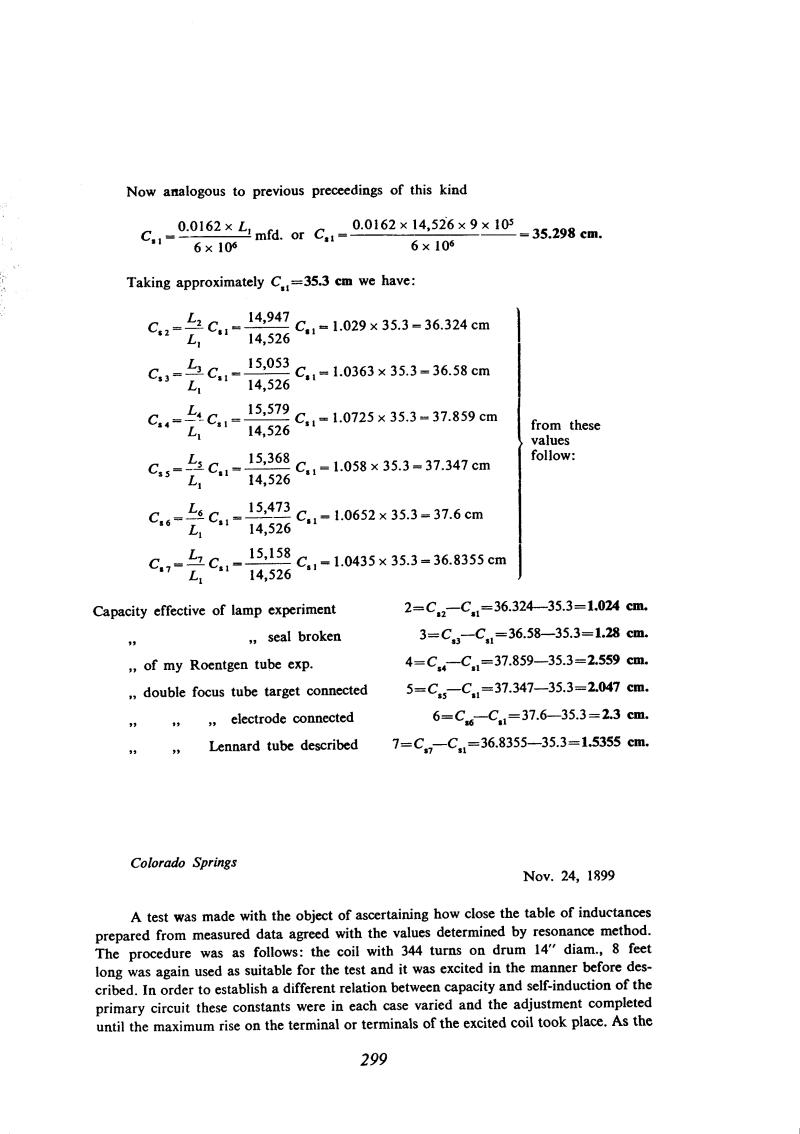
Nikola Tesla Books
Now analogous to previous proceedings of this kind
Cs1 = $! {{0.0162 \times L_{1}} \over {6 \times 10^{6}}} $! mfd. or Cs1 = $! {{0.0162x14,526x9x105} \over {6 \times 10^{6}}} $! = 35.298 cm.
Taking approximately Cs1 = 35.3 cm we have:
| Cs2 = $! {L_{2} \over L_{1}} $! Cs1 = $! {14,947 \over 14,526} $! Cs1 = 1.029 x 35.3 = 36.324 cm | } | from these values follows: |
| Cs3 = $! {L_{3} \over L_{1}} $! Cs1 = $! {15,053 \over 14,526} $! Cs1 = 1.0363 x 35.3 = 36.58 cm | ||
| Cs4 = $! {L_{4} \over L_{1}} $! Cs1 = $! {15,579 \over 14,526} $! Cs1 = 1.0725 x 35.3 = 37.859 cm | ||
| Cs5 = $! {L_{5} \over L_{1}} $! Cs1 = $! {15,368 \over 14,526} $! Cs1 = 1.058 x 35.3 = 37.347 cm | ||
| Cs6 = $! {L_{6} \over L_{1}} $! Cs1 = $! {15,473 \over 14,526} $! Cs1 = 1.0652 x 35.3 = 37.6 cm | ||
| Cs7 = $! {L_{7} \over L_{1}} $! Cs1 = $! {15,158 \over 14,526} $! Cs1 = 1.0435 x 35.3 = 36.8355 cm |
| Capacity effective of lamp experiment | 2 = Cs2 - Cs1 = 36.324 - 35.3 = 1.024 cm. |
| " " seal broken | 3 = Cs3 - Cs1 = 36.58 - 35.3 = 1.28 cm. |
| " of my Roentgen tube exp. | 4 = Cs4 - Cs1 = 37.859 - 35.3 = 2.559 cm. |
| " double focus tube target connected | 5 = Cs5 - Cs1 = 37.347 - 35.3 = 2.047 cm. |
| " " " electrode connected | 6 = Cs6 - Cs1 = 37.6 - 35.3 = 2.3 cm. |
| " " Lennard tube described | 7 = Cs7 - Cs1 = 36.8355 - 35.3 = 1.5355 cm. |
Colorado Springs
Nov. 24, 1899
A test was made with the object of ascertaining how close the table of inductance's prepared from measured data agreed with the values determined by resonance method. The procedure was as follows: the coil with 344 turns on drum 14" diam., 8 feet long was again used as suitable for the test and it was excited in the manner before described. In order to establish a different relation between capacity and self-induction of the primary circuit these constants were in each case varied and the adjustment completed until the maximum rise on the terminal or terminals of the excited coil took place. As the
299
November 24-26
To check the values for the inductance in the primary circuit (of the oscillator) which he had earlier measured by the voltage, current and frequency method (see October 30th), Tesla repeats these measurements using the resonance method. He described the procedure on October 21st and made some measurements but did not follow them up with calculations. This time he made both measurements and calculations, but only for one LpCp combination. He compares them with values derived from the table given November 8th using linear interpolation. He was probably satisfied with the agreement, and did not make further checks. He had measured the capacity of the same structure, but without the protective cap and using the âextraâ and âexperimentalâ coils, on November 7th. On November 12th he had made similar measurements using the 1314-turn coil. In the 26 November entry he refers to the result of 7 November with a new âextraâ coil. There is also one more result obtained with an âextra coilâ, using the best method he had developed for detecting resonance (see 13 November). This result, which differs appreciably from the others, is not mentioned November 26th.
The remark closing this entry suggests the possibility of systematic error in the determination of resonance, and Tesla emphasizes that it has to be checked.
November 24
He applies the resonant method in order to check previously obtained values for inductances in the primary circuit (oscillator circuit) by method of current, voltage and frequency (please see Oct. 30). He changes the elements in the oscillator circuit so as to obtain the unchanged multiplication of inductance with capacitance. He described the same procedure on Oct. 21 and he performed some measurements, but without calculations. This time he performed measurements and calculations, but only for one combination of CpLp. He made comparison with the results obtained from the table attached to Nov. 8 by application of linear interpolation. Probably satisfied with the match, he did not continue further checking.

